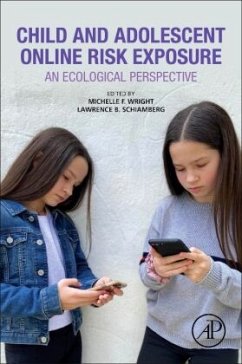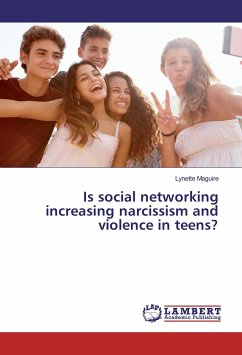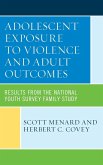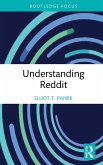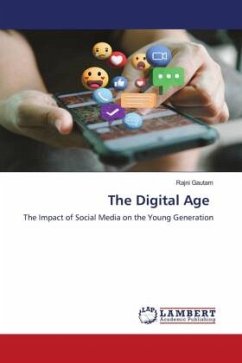Child and Adolescent Online Risk Exposure
An Ecological Perspective
Herausgegeben:Wright, Michelle F.; Schiamberg, Lawrence B.
Child and Adolescent Online Risk Exposure
An Ecological Perspective
Herausgegeben:Wright, Michelle F.; Schiamberg, Lawrence B.
- Broschiertes Buch
- Merkliste
- Auf die Merkliste
- Bewerten Bewerten
- Teilen
- Produkt teilen
- Produkterinnerung
- Produkterinnerung
Child and Adolescent Online Risk Exposure: An Ecological Perspective focuses on online risks and outcomes for children and adolescents using an ecological perspective (i.e., the intersection of individuals in relevant contexts) for a better understanding of risks associated with the youth online experience. The book examines the specific consequences of online risks for youth and demonstrates how to develop effective and sensitive interventions and policies. Sections discuss why online risks are important, individual and contextual factors, different types of risk, online risks among special…mehr
Andere Kunden interessierten sich auch für
![Is social networking increasing narcissism and violence in teens? Is social networking increasing narcissism and violence in teens?]() Lynette MaguireIs social networking increasing narcissism and violence in teens?16,99 €
Lynette MaguireIs social networking increasing narcissism and violence in teens?16,99 €![Adolescent Exposure to Violence and Adult Outcomes Adolescent Exposure to Violence and Adult Outcomes]() Scott MenardAdolescent Exposure to Violence and Adult Outcomes112,99 €
Scott MenardAdolescent Exposure to Violence and Adult Outcomes112,99 €![The Rate & Risk Factors of Substance Abuse Among High School Students The Rate & Risk Factors of Substance Abuse Among High School Students]() Carli LesterThe Rate & Risk Factors of Substance Abuse Among High School Students41,99 €
Carli LesterThe Rate & Risk Factors of Substance Abuse Among High School Students41,99 €![Great Depression in School Great Depression in School]() Jade C. JornalesGreat Depression in School29,99 €
Jade C. JornalesGreat Depression in School29,99 €![Understanding Reddit Understanding Reddit]() Elliot T. PanekUnderstanding Reddit64,99 €
Elliot T. PanekUnderstanding Reddit64,99 €![The Digital Age The Digital Age]() Rajni GautamThe Digital Age40,99 €
Rajni GautamThe Digital Age40,99 €![Research, Applications, and Interventions for Children and Adolescents Research, Applications, and Interventions for Children and Adolescents]() Research, Applications, and Interventions for Children and Adolescents77,99 €
Research, Applications, and Interventions for Children and Adolescents77,99 €-
-
-
Child and Adolescent Online Risk Exposure: An Ecological Perspective focuses on online risks and outcomes for children and adolescents using an ecological perspective (i.e., the intersection of individuals in relevant contexts) for a better understanding of risks associated with the youth online experience. The book examines the specific consequences of online risks for youth and demonstrates how to develop effective and sensitive interventions and policies. Sections discuss why online risks are important, individual and contextual factors, different types of risk, online risks among special populations, such as LGBT youth, physically or intellectually disabled youth, and ethnic and religious minorities, and intervention efforts.
Produktdetails
- Produktdetails
- Verlag: Academic Press / Elsevier Science & Technology
- Artikelnr. des Verlages: C2018-0-02272-0
- Englisch
- Abmessung: 22mm x 152mm x 229mm
- Gewicht: 750g
- ISBN-13: 9780128174999
- Artikelnr.: 59758502
- Herstellerkennzeichnung Die Herstellerinformationen sind derzeit nicht verfügbar.
- Verlag: Academic Press / Elsevier Science & Technology
- Artikelnr. des Verlages: C2018-0-02272-0
- Englisch
- Abmessung: 22mm x 152mm x 229mm
- Gewicht: 750g
- ISBN-13: 9780128174999
- Artikelnr.: 59758502
- Herstellerkennzeichnung Die Herstellerinformationen sind derzeit nicht verfügbar.
Preface
Section I: Introduction
1. Introduction
Lawrence B. Schiamberg and Michelle F. Wright
Section II: Types of Online Risks
2. Problematic internet use: causes, consequences, and future directions
Michelle F. Wright, Tali Heiman and Dorit Olenik-Shemesh
3. The process of exploitation and victimization of adolescents in digital environments: the contribution of authenticity and self-exploration
John D. Ranney
4. Online contact risk behaviors and risk factors among Japanese high school students
Ikuko Aoyama
5. Understanding child and adolescent cyberbullying
Oonagh L. Steer, Peter J.R. Macaulay and Lucy R. Betts
6. Online aggression and romantic relationships in adolescence
Chelsea Olson and Amy Bellmore
7. The longitudinal associations of cyberbullying and cybervictimization: preliminary findings from a two-wave study
Fatih Bayraktar and Michelle F. Wright
8. The rising threat of cyberhate for young people around the globe
Sheri Bauman, Vanessa M. Perry and Sebastian Wachs
9. Same incident, different story? Investigating early adolescents' negative online peer interactions from different perspectives
Sara Pabian, Sara Erreygers, Kathleen Van Royen and Heidi Vandebosch
Section III: Special Populations and Online Risks
10. Parental vigilance, low self-control, and Internet dependency among rural adolescents
Magda Javakhishvili and Alexander T. Vazsonyi
11. Cyberbullying perpetration and victimization among ethnic minority youth in the United States: similarities or differences across groups?
Guadalupe Espinoza and Fardusa Rashid Ismail
12. Racial and ethnic diversity in the social ecology of online harassment and cybervictimization: the adolescent school context
Gia Elise Barboza and Lawrence B. Schiamberg
13. Cyberbullying and cybervictimization among youth with disabilities
Morgan A. Eldridge, Michelle L. Kilpatrick Demaray, Jonathan D. Emmons and Logan N. Riffle
14. The negative online experiences of maltreated children and adolescents
Michelle F. Wright
15. LGBTQ youth and digital media: online risks
Tyler Hatchel, Cagil Torgal, America J. El Sheikh, Luz E. Robinson, Alberto Valido and Dorothy L. Espelage
16. Gendered nature of digital abuse in romantic relationships in adolescence
Beatriz VÍllora, Santiago Yubero, Elisa Larrañaga and Raúl Navarro
Section IV: Interventions and Policies
17. Advances in the cyberbullying literature: theory-based interventions
Christopher P. Barlett, Matthew M. Simmers and Luke W. Seyfert
18. Online risk interventions: implications of theory of mind and other considerations
Tina Montreuil and Hagit Malikin
19. Using focus groups and quality circles to enable pupil voice in European teenagers from socioeconomically disadvantaged backgrounds
Noel Purdy, Jayne Hamilton, Peter K. Smith, Catherine Culbert, Herbert Scheithauer, Nora Fiedler, Antonella Brighi, Consuelo Mameli, Annalisa Guarini, Damiano Menin, Trijntje Völlink and Roy A. Willems
20. Conclusion
Michelle F. Wright and Lawrence B. Schiamberg
Section I: Introduction
1. Introduction
Lawrence B. Schiamberg and Michelle F. Wright
Section II: Types of Online Risks
2. Problematic internet use: causes, consequences, and future directions
Michelle F. Wright, Tali Heiman and Dorit Olenik-Shemesh
3. The process of exploitation and victimization of adolescents in digital environments: the contribution of authenticity and self-exploration
John D. Ranney
4. Online contact risk behaviors and risk factors among Japanese high school students
Ikuko Aoyama
5. Understanding child and adolescent cyberbullying
Oonagh L. Steer, Peter J.R. Macaulay and Lucy R. Betts
6. Online aggression and romantic relationships in adolescence
Chelsea Olson and Amy Bellmore
7. The longitudinal associations of cyberbullying and cybervictimization: preliminary findings from a two-wave study
Fatih Bayraktar and Michelle F. Wright
8. The rising threat of cyberhate for young people around the globe
Sheri Bauman, Vanessa M. Perry and Sebastian Wachs
9. Same incident, different story? Investigating early adolescents' negative online peer interactions from different perspectives
Sara Pabian, Sara Erreygers, Kathleen Van Royen and Heidi Vandebosch
Section III: Special Populations and Online Risks
10. Parental vigilance, low self-control, and Internet dependency among rural adolescents
Magda Javakhishvili and Alexander T. Vazsonyi
11. Cyberbullying perpetration and victimization among ethnic minority youth in the United States: similarities or differences across groups?
Guadalupe Espinoza and Fardusa Rashid Ismail
12. Racial and ethnic diversity in the social ecology of online harassment and cybervictimization: the adolescent school context
Gia Elise Barboza and Lawrence B. Schiamberg
13. Cyberbullying and cybervictimization among youth with disabilities
Morgan A. Eldridge, Michelle L. Kilpatrick Demaray, Jonathan D. Emmons and Logan N. Riffle
14. The negative online experiences of maltreated children and adolescents
Michelle F. Wright
15. LGBTQ youth and digital media: online risks
Tyler Hatchel, Cagil Torgal, America J. El Sheikh, Luz E. Robinson, Alberto Valido and Dorothy L. Espelage
16. Gendered nature of digital abuse in romantic relationships in adolescence
Beatriz VÍllora, Santiago Yubero, Elisa Larrañaga and Raúl Navarro
Section IV: Interventions and Policies
17. Advances in the cyberbullying literature: theory-based interventions
Christopher P. Barlett, Matthew M. Simmers and Luke W. Seyfert
18. Online risk interventions: implications of theory of mind and other considerations
Tina Montreuil and Hagit Malikin
19. Using focus groups and quality circles to enable pupil voice in European teenagers from socioeconomically disadvantaged backgrounds
Noel Purdy, Jayne Hamilton, Peter K. Smith, Catherine Culbert, Herbert Scheithauer, Nora Fiedler, Antonella Brighi, Consuelo Mameli, Annalisa Guarini, Damiano Menin, Trijntje Völlink and Roy A. Willems
20. Conclusion
Michelle F. Wright and Lawrence B. Schiamberg
Preface
Section I: Introduction
1. Introduction
Lawrence B. Schiamberg and Michelle F. Wright
Section II: Types of Online Risks
2. Problematic internet use: causes, consequences, and future directions
Michelle F. Wright, Tali Heiman and Dorit Olenik-Shemesh
3. The process of exploitation and victimization of adolescents in digital environments: the contribution of authenticity and self-exploration
John D. Ranney
4. Online contact risk behaviors and risk factors among Japanese high school students
Ikuko Aoyama
5. Understanding child and adolescent cyberbullying
Oonagh L. Steer, Peter J.R. Macaulay and Lucy R. Betts
6. Online aggression and romantic relationships in adolescence
Chelsea Olson and Amy Bellmore
7. The longitudinal associations of cyberbullying and cybervictimization: preliminary findings from a two-wave study
Fatih Bayraktar and Michelle F. Wright
8. The rising threat of cyberhate for young people around the globe
Sheri Bauman, Vanessa M. Perry and Sebastian Wachs
9. Same incident, different story? Investigating early adolescents' negative online peer interactions from different perspectives
Sara Pabian, Sara Erreygers, Kathleen Van Royen and Heidi Vandebosch
Section III: Special Populations and Online Risks
10. Parental vigilance, low self-control, and Internet dependency among rural adolescents
Magda Javakhishvili and Alexander T. Vazsonyi
11. Cyberbullying perpetration and victimization among ethnic minority youth in the United States: similarities or differences across groups?
Guadalupe Espinoza and Fardusa Rashid Ismail
12. Racial and ethnic diversity in the social ecology of online harassment and cybervictimization: the adolescent school context
Gia Elise Barboza and Lawrence B. Schiamberg
13. Cyberbullying and cybervictimization among youth with disabilities
Morgan A. Eldridge, Michelle L. Kilpatrick Demaray, Jonathan D. Emmons and Logan N. Riffle
14. The negative online experiences of maltreated children and adolescents
Michelle F. Wright
15. LGBTQ youth and digital media: online risks
Tyler Hatchel, Cagil Torgal, America J. El Sheikh, Luz E. Robinson, Alberto Valido and Dorothy L. Espelage
16. Gendered nature of digital abuse in romantic relationships in adolescence
Beatriz VÍllora, Santiago Yubero, Elisa Larrañaga and Raúl Navarro
Section IV: Interventions and Policies
17. Advances in the cyberbullying literature: theory-based interventions
Christopher P. Barlett, Matthew M. Simmers and Luke W. Seyfert
18. Online risk interventions: implications of theory of mind and other considerations
Tina Montreuil and Hagit Malikin
19. Using focus groups and quality circles to enable pupil voice in European teenagers from socioeconomically disadvantaged backgrounds
Noel Purdy, Jayne Hamilton, Peter K. Smith, Catherine Culbert, Herbert Scheithauer, Nora Fiedler, Antonella Brighi, Consuelo Mameli, Annalisa Guarini, Damiano Menin, Trijntje Völlink and Roy A. Willems
20. Conclusion
Michelle F. Wright and Lawrence B. Schiamberg
Section I: Introduction
1. Introduction
Lawrence B. Schiamberg and Michelle F. Wright
Section II: Types of Online Risks
2. Problematic internet use: causes, consequences, and future directions
Michelle F. Wright, Tali Heiman and Dorit Olenik-Shemesh
3. The process of exploitation and victimization of adolescents in digital environments: the contribution of authenticity and self-exploration
John D. Ranney
4. Online contact risk behaviors and risk factors among Japanese high school students
Ikuko Aoyama
5. Understanding child and adolescent cyberbullying
Oonagh L. Steer, Peter J.R. Macaulay and Lucy R. Betts
6. Online aggression and romantic relationships in adolescence
Chelsea Olson and Amy Bellmore
7. The longitudinal associations of cyberbullying and cybervictimization: preliminary findings from a two-wave study
Fatih Bayraktar and Michelle F. Wright
8. The rising threat of cyberhate for young people around the globe
Sheri Bauman, Vanessa M. Perry and Sebastian Wachs
9. Same incident, different story? Investigating early adolescents' negative online peer interactions from different perspectives
Sara Pabian, Sara Erreygers, Kathleen Van Royen and Heidi Vandebosch
Section III: Special Populations and Online Risks
10. Parental vigilance, low self-control, and Internet dependency among rural adolescents
Magda Javakhishvili and Alexander T. Vazsonyi
11. Cyberbullying perpetration and victimization among ethnic minority youth in the United States: similarities or differences across groups?
Guadalupe Espinoza and Fardusa Rashid Ismail
12. Racial and ethnic diversity in the social ecology of online harassment and cybervictimization: the adolescent school context
Gia Elise Barboza and Lawrence B. Schiamberg
13. Cyberbullying and cybervictimization among youth with disabilities
Morgan A. Eldridge, Michelle L. Kilpatrick Demaray, Jonathan D. Emmons and Logan N. Riffle
14. The negative online experiences of maltreated children and adolescents
Michelle F. Wright
15. LGBTQ youth and digital media: online risks
Tyler Hatchel, Cagil Torgal, America J. El Sheikh, Luz E. Robinson, Alberto Valido and Dorothy L. Espelage
16. Gendered nature of digital abuse in romantic relationships in adolescence
Beatriz VÍllora, Santiago Yubero, Elisa Larrañaga and Raúl Navarro
Section IV: Interventions and Policies
17. Advances in the cyberbullying literature: theory-based interventions
Christopher P. Barlett, Matthew M. Simmers and Luke W. Seyfert
18. Online risk interventions: implications of theory of mind and other considerations
Tina Montreuil and Hagit Malikin
19. Using focus groups and quality circles to enable pupil voice in European teenagers from socioeconomically disadvantaged backgrounds
Noel Purdy, Jayne Hamilton, Peter K. Smith, Catherine Culbert, Herbert Scheithauer, Nora Fiedler, Antonella Brighi, Consuelo Mameli, Annalisa Guarini, Damiano Menin, Trijntje Völlink and Roy A. Willems
20. Conclusion
Michelle F. Wright and Lawrence B. Schiamberg

